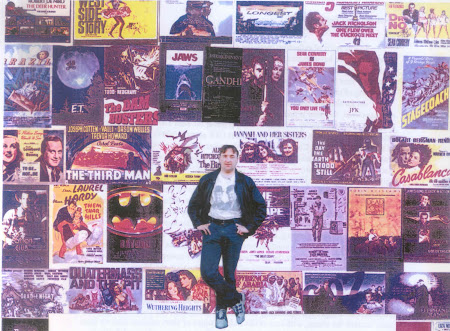 This is a gem of a film, only three reels (30 minutes) long, but too brilliant to deny being included on this 100 list.
This is a gem of a film, only three reels (30 minutes) long, but too brilliant to deny being included on this 100 list.I'll admit it, I often cry when I watch movies: often it's not too difficult if the film is doing its job, and the intensity of feeling and focus on the emotions in the cinema is so much more suited than anywhere else.
A small boy (the director's 12-year old son) is given a red balloon for a companion, and it soon becomes a character in its own right, every bit as young, cheeky and innocent as the boy himself. He takes it around with him whenever he can, on the grimy atmospheric streets of Paris, to his delight but to the annoyance of his parents and crusty schoolteacher, and the vengeful jealousy of other boys (the scene where the balloon is punctured and gradually deflates, is unbearably sad.)
But then there is the finale that always has me tearful, where all the other balloons in Paris - of whatever colour - fly up into the sky and descend on the little boy and carry him heavenwards, accompanied by a sentimental but memorable score by Maurice le Roux. Technically this is quite an accomplishment, although you can probably see the wires dangling above the balloons from time to time, not that this really matters. It's not too
 difficult to see where Spielberg got some of his artistic inspiration for films such as E.T. and Schindler's List (the little girl in red) from.
difficult to see where Spielberg got some of his artistic inspiration for films such as E.T. and Schindler's List (the little girl in red) from.The Red Balloon (or Le Balon Rouge if you want to be French) is, to put it simply, a masterpiece - and I use that term very rarely.
Other Shorts
While we're covering the subject of classic short films, I'll take the opportunity to shoehorn one or two more fa
 vourites into this blog. (In the case of Laurel & Hardy, see Way Out West.) I have to mention what is for me The Red Balloon's partner piece, THE SNOWMAN (1982), also a film about childhood innocence with a heartbreaking ending. It's hard to look at the film objectively nowadays as it's become such a cultural phenomenon since then, and strictly speaking it was made for television (a regular on Channel 4 every Christmas), but Diane Jackson's animation of Raymond Brigg's illustrated children's book does have a special cinematic magic about it.
vourites into this blog. (In the case of Laurel & Hardy, see Way Out West.) I have to mention what is for me The Red Balloon's partner piece, THE SNOWMAN (1982), also a film about childhood innocence with a heartbreaking ending. It's hard to look at the film objectively nowadays as it's become such a cultural phenomenon since then, and strictly speaking it was made for television (a regular on Channel 4 every Christmas), but Diane Jackson's animation of Raymond Brigg's illustrated children's book does have a special cinematic magic about it. I remembered seeing a film on television decades ago,
I remembered seeing a film on television decades ago,and later discovered it was called COSMIC ZOOM (1968), about a boy and a dog in a boat (again, the simplicity of childhood theme) at which point the camera zooms out - out of the lake in Montreal where the boat is travelling, out to the edge of the Earth, then beyond the Sun, to the outer reaches of the galaxy, to the furthest known point in outer space - and then it zooms in - back to the Earth, to the lake, the boy, and then further in towards the blood cells of a small mosquito bite on his arm, to its infinite micro organisms (DNA was not developed back in 1968) right down to the atom.
Probably the most startling and avant garde of all short films ever made is UN CHIEN ANDALOU (1938), conceived by Luis Bunuel and Salvador Dali as a deliberately abstract piece of work
 which is nonetheless nightmarishly bizarre in its concept and execution, and most of all, the images are striking. Any cinematic history lesson would be incomplete without a viewing of it.
which is nonetheless nightmarishly bizarre in its concept and execution, and most of all, the images are striking. Any cinematic history lesson would be incomplete without a viewing of it.Nor indeed, is the first ever cinema film ever made, known under no particular title other than LEAVING THE LUMIERE FACTORY (1895) (La Sortie des Usines Lumiere), a simple but historical piece of film where the employees at the factory run by the Lumiere brothers (who considered moving pictures just a novelty) stand outside the factory door at closing time. It was the first of a programme of 1-minute unedited moving picture sensations at the Grand Cafe of the Boulevard des Capucines in Paris, in December 1895 - the birth of cinema.
If you notice a French theme running through most of these short films, well, they were practically the inventors of cinema after all (Edison and a few others notwithstanding), and I'll claim a little birthday connection with cinema history here: it was on 19th March 1895, that those employees were filmed leaving the Paris factory.


















































